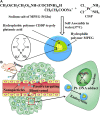Effect of Micelle-Incorporated Cisplatin With Sizes Ranging From 8 to 40 nm for the Therapy of Lewis Lung Carcinoma
- PMID: 33762955
- PMCID: PMC7982401
- DOI: 10.3389/fphar.2021.632877
Effect of Micelle-Incorporated Cisplatin With Sizes Ranging From 8 to 40 nm for the Therapy of Lewis Lung Carcinoma
Abstract
Insufficient transport of therapeutic cargo into tumor bed is a bottleneck in cancer nanomedicine. Block copolymers are promising carriers with smaller particle size by ratio modification. Here, we constructed cisplatin nanoparticles with sizes ranging from 8 to 40 nm to study the permeability and therapy of Lewis lung carcinoma. We synthesized methoxypoly(ethylene glycol)2000-block poly(L-glutamic acid sodium salt)1979 loading cisplatin through complexation reaction. The cisplatin nanomedicine has high drug loading and encapsulation efficiency. In vitro data demonstrated that cisplatin nanoparticles had equivalent growth-inhibiting effects on Lewis lung carcinoma cells compared to free cisplatin. In vivo evidences showed cisplatin nanoparticles had superior antitumor effects on the Lewis lung carcinoma mouse model with no obvious side effects. All results indicated that optimizing the ratio of block copolymers to obtain smaller sized nanomedicine could act as a promising strategy for overcoming the inadequate accumulation in poorly vascularized tumors.
Keywords: block copolymers; cisplatin; drug delivery; lung cancer; nanomedicine; nanoparticles.
Copyright © 2021 Wang, Li, Zhang, Li, Yang and Wang.
Conflict of interest statement
The authors declare that the research was conducted in the absence of any commercial or financial relationships that could be construed as a potential conflict of interest.
Figures










Similar articles
-
Pharmacokinetics, biodistribution and in vivo efficacy of cisplatin loaded poly(L-glutamic acid)-g-methoxy poly(ethylene glycol) complex nanoparticles for tumor therapy.J Control Release. 2015 May 10;205:89-97. doi: 10.1016/j.jconrel.2014.12.022. Epub 2014 Dec 18. J Control Release. 2015. PMID: 25529533
-
Synergistic Antitumor Efficacy Mediated by Liposomal Co-Delivery of Polymeric Micelles of Vinorelbine and Cisplatin in Non-Small Cell Lung Cancer.Int J Nanomedicine. 2021 Mar 22;16:2357-2372. doi: 10.2147/IJN.S290263. eCollection 2021. Int J Nanomedicine. 2021. PMID: 33790554 Free PMC article.
-
Combination Therapy of Lung Cancer Using Layer-by-Layer Cisplatin Prodrug and Curcumin Co-Encapsulated Nanomedicine.Drug Des Devel Ther. 2020 Jun 9;14:2263-2274. doi: 10.2147/DDDT.S241291. eCollection 2020. Drug Des Devel Ther. 2020. PMID: 32606596 Free PMC article.
-
Paclitaxel-incorporated nanoparticles using block copolymers composed of poly(ethylene glycol)/poly(3-hydroxyoctanoate).Nanoscale Res Lett. 2014 Sep 24;9(1):525. doi: 10.1186/1556-276X-9-525. eCollection 2014. Nanoscale Res Lett. 2014. PMID: 25288916 Free PMC article.
-
Role of integrated cancer nanomedicine in overcoming drug resistance.Adv Drug Deliv Rev. 2013 Nov;65(13-14):1784-802. doi: 10.1016/j.addr.2013.07.012. Epub 2013 Jul 21. Adv Drug Deliv Rev. 2013. PMID: 23880506 Review.
Cited by
-
H-Dot Mediated Nanotherapeutics Mitigate Systemic Toxicity of Platinum-Based Anticancer Drugs.Int J Mol Sci. 2023 Oct 23;24(20):15466. doi: 10.3390/ijms242015466. Int J Mol Sci. 2023. PMID: 37895146 Free PMC article.
References
LinkOut - more resources
Full Text Sources
Other Literature Sources

